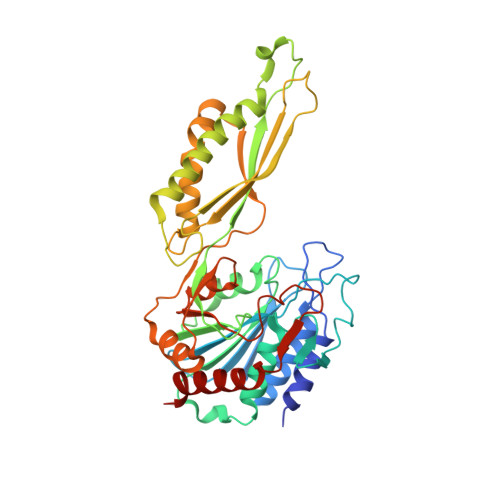N alpha-acetyl-L-ornithine deacetylase from Escherichia coli and a ninhydrin-based assay to enable inhibitor identification.
Kelley, E.H., Osipiuk, J., Korbas, M., Endres, M., Bland, A., Ehrman, V., Joachimiak, A., Olsen, K.W., Becker, D.P.(2024) Front Chem 12: 1415644-1415644
- PubMed: 39055043
- DOI: https://doi.org/10.3389/fchem.2024.1415644
- Primary Citation of Related Structures:
8UW6 - PubMed Abstract:
Bacteria are becoming increasingly resistant to antibiotics, therefore there is an urgent need for new classes of antibiotics to fight antibiotic resistance. Mammals do not express N ɑ -acetyl-L-ornithine deacetylase (ArgE), an enzyme that is critical for bacterial survival and growth, thus ArgE represents a promising new antibiotic drug target, as inhibitors would not suffer from mechanism-based toxicity. A new ninhydrin-based assay was designed and validated that included the synthesis of the substrate analog N 5 , N 5 -di-methyl N α -acetyl-L-ornithine (k cat /K m = 7.32 ± 0.94 × 10 4 M -1 s -1 ). This new assay enabled the screening of potential inhibitors that absorb in the UV region, and thus is superior to the established 214 nm assay. Using this new ninhydrin-based assay, captopril was confirmed as an ArgE inhibitor (IC 50 = 58.7 μM; K i = 37.1 ± 0.85 μM), and a number of phenylboronic acid derivatives were identified as inhibitors, including 4-(diethylamino)phenylboronic acid (IC 50 = 50.1 μM). Selected inhibitors were also tested in a thermal shift assay with ArgE using SYPRO Orange dye against Escherichia coli ArgE to observe the stability of the enzyme in the presence of inhibitors (captopril K i = 35.9 ± 5.1 μM). The active site structure of di-Zn Ec ArgE was confirmed using X-ray absorption spectroscopy, and we reported two X-ray crystal structures of E. coli ArgE. In summary, we describe the development of a new ninhydrin-based assay for ArgE, the identification of captopril and phenylboronic acids as ArgE inhibitors, thermal shift studies with ArgE + captopril, and the first two published crystal structures of ArgE (mono-Zn and di-Zn).
- Department of Chemistry and Biochemistry, Loyola University Chicago, Chicago, IL, United States.
Organizational Affiliation:




















